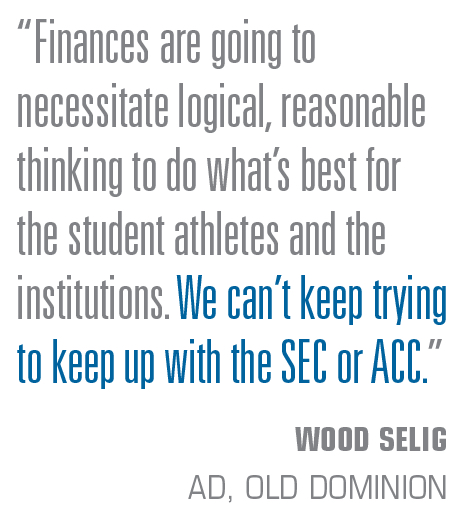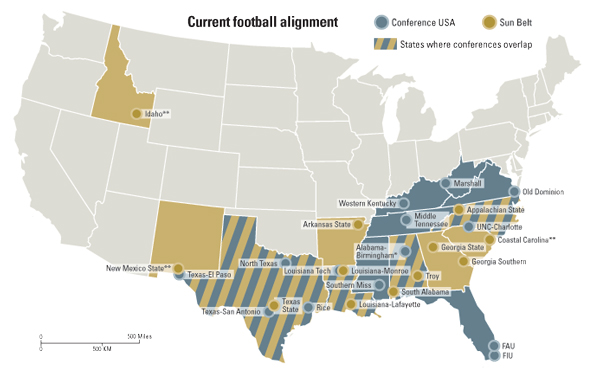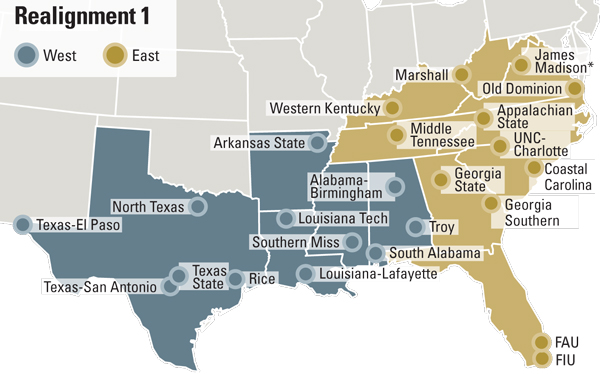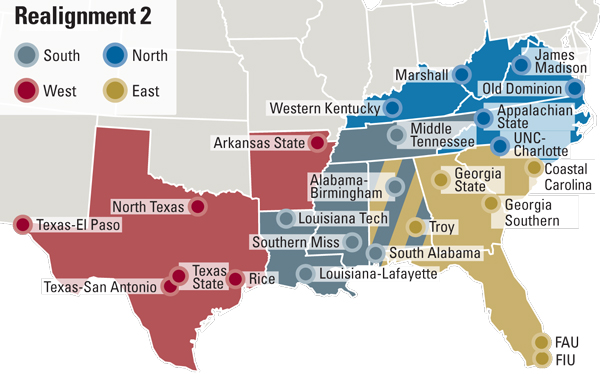The most recent rounds of conference realignment might have created an economic boon for the power five, but the fallout for the rest of the FBS leagues left them in a wasteland where schools fly halfway across the country to play against unfamiliar opponents.
Nowhere is that more evident than in a pair of mid-major leagues — Conference USA and the Sun Belt — that sit at the bottom of the FBS pecking order.
Both conferences span the Mid-Atlantic states across the Southeast and into Texas and New Mexico, sharing essentially the same nonsensical footprint.
One week, Charlotte travels 1,600 miles to El Paso, Texas, for a CUSA matchup. The next week, Appalachian State
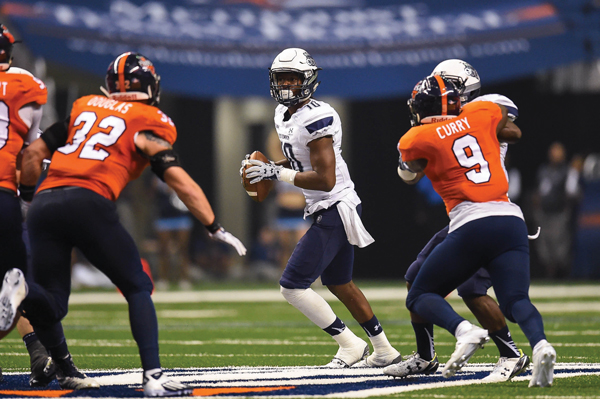 |
Conference USA’s membership covers a large footprint, resulting in matchups such as Old Dominion and Texas-San Antonio (above) that require long-distance travel.
Photo by: Newscom |
flies nearly 1,700 miles to Las Cruces, N.M., to face New Mexico State. Charlotte and App State, separated by 100 miles and potentially natural rivals with their overlapping fan bases, play only if they schedule the occasional nonconference game.
So what’s the solution for these mid-majors that are trying to look like and act like the big boys?
Very simply, CUSA and the Sun Belt would take their 24 football-playing members and divide them geographically into two new conferences. The dozen easternmost schools would form one conference and the dozen westernmost schools would form the other conference.
Conference USA would represent the schools to the east. The Sun Belt would take the schools to the west. Or vice versa. Pick a conference name — it really doesn’t matter.
Essentially, the western half would go from Alabama to Texas. The eastern half would cover Virginia, Tennessee, Georgia, North and South Carolina, and Florida.
Not only would schools save significantly on travel costs across all of their sports — an estimated $500,000 to $1 million a year in savings — they’d also play schools closer to them, creating the opportunity to develop regional rivalries and sell more tickets.
“College football is all about regional rivalries,” said Terry Mohajir, athletic director at Arkansas State in the Sun Belt. “What’s best for college football? It’s games that your fans can attend. Fans can’t travel to these games anymore.
“If you’re playing a bunch of opponents that make your fans say, ‘Who cares?,’ there’s not going to be any interest.”
No conference would ever start from scratch and come up with the geographically dispersed collection of schools that both CUSA and the Sun Belt now feature. But this is what CUSA and the Sun Belt are left with in today’s post-realignment world.
Most recently, the threat of decreasing media revenue and increasing travel costs has officials in both conferences searching for alternative formats, especially if new or revamped leagues can bring schools closer together and save money. The increasing cost of doing business at the FBS level — paying cost of attendance and funding 24/7 training tables are two examples — also has added pressure to the budgets of those schools trying to keep pace with the power five.
That’s led to casual conversations about the kind of realignment outside the power five that would bring common sense back to the table.
By the time the 2017 football season starts, CUSA will have 14 football-playing members stretching from Old Dominion in Norfolk, Va., to Texas-El Paso. The Sun Belt will reduce its football membership to 10 by cutting New Mexico State and Idaho, while adding Coastal Carolina, but the league will still reach from the Carolinas to Texas.
While that might work for higher-resource conferences like the SEC, such a wide range of schools adds significantly to travel costs and missed class time, especially for the Olympic sports.
“Finances are going to necessitate logical, reasonable thinking to do what’s best for the student athletes and the institutions,” said Wood Selig, athletic director at Old Dominion in CUSA. “We can’t keep trying to keep up with the SEC or ACC.”
To be clear, neither CUSA nor the Sun Belt claims to be officially exploring this kind of shake-up, even though realignment could remedy some or all of the three most pressing issues for these schools — decreasing revenue, increasing costs and missed class time.
Sun Belt Commissioner Karl Benson met with his board of presidents earlier this month, and he was more than happy to report that new membership wasn’t on the agenda for the first time since he became commissioner in 2012.
But the former WAC commissioner is no stranger to realignment scenarios and innovative thinking. Soon after
taking the Sun Belt job, Benson proposed a 33-team super conference made up of schools just out of the power five. There was no interest.
CUSA and the Mountain West had conversations of their own about an alliance nearly five years ago. But like the super conference model, those ideas faded.
CUSA Commissioner Judy MacLeod said for now she’s not commenting on speculative conference realignment scenarios like this one.
Interviews with a third of the CUSA and Sun Belt athletic directors, however, revealed that alternative models need to be studied. No one disputed that they need to look closely at better cost-containment measures at a time when TV revenue is slipping.
“When viewed objectively and without emotion, I think most would agree that some type of alternate structure, based on geography, makes economic sense,” said Dean Jordan, a media consultant for Wasserman who worked with CUSA on its most recent negotiations. “But this is understandably an emotional issue with multiple aspects to consider, which often makes objectivity difficult.”
It’s simply not sustainable to keep running these lower-level FBS conferences like the power five, representatives from both the Sun Belt and CUSA said.
Besides the financial stress schools are feeling, they also are shipping their athletes halfway across the country to compete. Some Olympic sports teams will bus up to 10 hours each way.
“Whether you’re a power five school or Division III, geography is hugely important,” Georgia State AD Charlie Cobb said. “It helps develop geographic rivalries, it cuts down on missed class time, it limits expenses. It’s a pretty simple answer to a lot of people’s concerns.”
The economic realities of running a lower-level FBS program came into a crude focus recently.
In CUSA’s most recent media rights negotiations last year, the conference took a staggering 80 percent haircut, with per-school revenue slipping from $1 million a year to $200,000.
With half of its members leaping to the American Athletic Conference over the last few years, CUSA found college TV stalwarts like ESPN and Fox, which have been tightening their own purse strings, showing little interest in its product. The league finally settled on deals with four different channels.
“The revenue is drying up,” ODU’s Selig said. “All the money [from TV] is going to the power five and we’re left with crumbs.”
Sun Belt schools make slightly less from media rights — about $140,000 annually.
“It’s going to take a fiscally dramatic event to get something to happen,” Middle Tennessee State AD Chris Massaro said. “I’m not sure we’ve hit that financial crisis yet. When you hit a crisis, people will put their egos aside.”
The institutional egos Massaro referenced are one of the chief impediments to geographic realignment. Many of CUSA’s members — Western Kentucky, Middle Tennessee State, North Texas, among others — came from the Sun Belt, so they question why they’d want to go back in business with them.
But when they left, those schools were going to a new conference based on the promise of greater paydays. Now, the media revenue isn’t all that different.
Despite the egos in play, conversations with ADs from both conferences revealed a number of interesting ideas, in addition to simple geographic realignment.
Schools could form a 24-team super conference in football that would operate independently from the other
Olympic sports.
Rather than form two 12-team conferences, the schools could split into four divisions of six teams. The four division winners would play on Thanksgiving with the two finalists playing in a championship game on the first weekend in December.
Some believe that the American, which is similarly dispersed geographically, should surrender its pursuit of the power five and join in a non-power five realignment.
Two schools that could be most vulnerable are UTEP in CUSA because of its remote location and the Sun Belt’s Louisiana-Monroe, which is struggling to keep up financially. Annual athletic budgets mostly range from $20 million to $30 million for schools in these two leagues. ULM reported $13 million in revenue from its 2014-15 academic year.
If there are casualties in realignment, other FCS schools such as James Madison, which boasts an annual budget of more than $40 million, are ready to step in.
Whatever form realignment might take, ADs clearly are already thinking about some of these alternative models.
Ultimately, Arkansas State’s Mohajir predicted, schools at this level will have to go back to the old financial model, where ticket sales and donations drive the majority of revenue, not TV.
“If you can’t generate revenue from TV, you’ve got to do it through ticket sales and donations,” Mohajir said. “And with few exceptions, the greatest rivalries are regionally based.
“Common sense has to prevail.”


